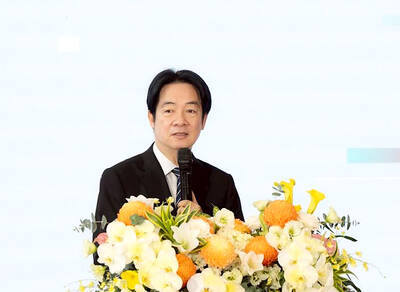A suicide attacker detonated an explosives-packed vehicle near a row of police cars blocking off a bridge in central Baghdad yesterday, killing at least five people and wounding 20, officials said.
The attack came hours after US jets pounded the insurgent stronghold of Fallujah, leaving at least 44 dead.
It was the second car bombing this week targeting Baghdad police forces, part of a stepped-up campaign of violence to thwart US-backed efforts to strengthen the Iraqi security forces and bring stability to the country ahead of January elections.
A half-dozen cars were blocking a bridge when a car drew up to them, policeman Ammar Ali said. Police asked the driver to stop, but he continued to advance and exploded his vehicle in the middle of the parked cars, Ali said.
"I was thrown outside my car," said another policeman, Ali Jabar, who was being treated for wounds to his face and a hand at the city's main Medical City hospital.
He blamed insurgents waging a 17-month campaign against Iraqi authorities and the US-led coalition in Iraq.
"By attacking Iraqi police, they think that they will be sent to heaven, but by God's will, they are now melting in hell," Jabar said from his hospital bed.
The Iraqi Health Ministry said at least five people were killed and 20 wounded in the midday attack, which happened on a busy market day. Police fired shots to disperse the crowd and thousands of shoppers streamed from the area.
"I saw human flesh and blood in the street, then I fled," Mouayad Shehab said as he escaped the scene.
The police vehicles had been helping to seal off the area around Haifa Street, where US and Iraqi forces had raided suspected insurgent hideouts yesterday morning, sparking a gunbattle.
Security forces arrested 63 suspects, including Syrians, Sudanese and Egyptians, during the sweeps on Haifa street, a virtual "no go" area for US forces, Interior Ministry spokesman Sabah Kadhim said. Caches of weapons, including rockets, grenades and machine guns were also seized, he said.
There was no immediate word on casualties.
West of Baghdad, an initial wave of US airstrikes late on Thursday targeted a compound in Fazat Shnetir, about 20km south of Fallujah, where militants loyal to the Jordanian-born terror mastermind Abu Musab al-Zarqawi were meeting to plot attacks on coalition forces, the military said in a statement.
Militants who survived the strikes later sought refuge in nearby villages, but US forces said they quickly broke off an offensive to hunt them down to avoid civilian casualties. Residents of Fazat Shnetir could be seen digging communal graves yesterday to bury the dead in groups of four.
Early yesterday, US warplanes unleashed strikes on a cluster of houses believed to be used by members of Zarqawi's Tawhid and Jihad group inside Fallujah, the military said.
Blood covered the floors of the Fallujah General Hospital as doctors struggled to cope with a flood of casualties, many brought to the hospital in private cars since ambulances were overwhelmed.
Relatives pounded their chests in grief and denounced the US.
Health Ministry spokesman Saad al-Amili said at least 44 people were killed and 27 injured in the strikes.
Early yesterday, police found the corpse of a man they believed to be a Westerner about 65km north of Baghdad. The man, described as tall and well built with blonde hair, had been shot in the back of the head.
Also See Story:

MISINFORMATION: The generated content tends to adopt China’s official stance, such as ‘Taiwan is currently governed by the Chinese central government,’ the NSB said Five China-developed artificial intelligence (AI) language models exhibit cybersecurity risks and content biases, an inspection conducted by the National Security Bureau (NSB) showed. The five AI tools are: DeepSeek, Doubao (豆包), Yiyan (文心一言), Tongyi (通義千問) and Yuanbao (騰訊元寶), the bureau said, advising people to remain vigilant to protect personal data privacy and corporate business secrets. The NSB said it, in accordance with the National Intelligence Services Act (國家情報工作法), has reviewed international cybersecurity reports and intelligence, and coordinated with the Ministry of Justice Investigation Bureau and the National Police Agency’s Criminal Investigation Bureau to conduct an inspection of China-made AI language

BOOST IN CONFIDENCE: The sale sends a clear message of support for Taiwan and dispels rumors that US President Donald Trump ‘sold out’ the nation, an expert said The US government on Thursday announced a possible sale to Taiwan of fighter jet parts, which was estimated to cost about US$330 million, in a move that an expert said “sends a clear message of support for Taiwan” amid fears that Washington might be wavering in its attitude toward Taipei. It was the first announcement of an arms sale to Taiwan since US President Donald Trump returned to the White House earlier this year. The proposed package includes non-standard components, spare and repair parts, consumables and accessories, as well repair and return support for the F-16, C-130 and Indigenous Defense Fighter aircraft,

CHECKING BOUNDARIES: China wants to disrupt solidarity among democracies and test their red lines, but it is instead pushing nations to become more united, an expert said The US Department of State on Friday expressed deep concern over a Chinese public security agency’s investigation into Legislator Puma Shen (沈伯洋) for “secession.” “China’s actions threaten free speech and erode norms that have underpinned the cross-strait ‘status quo’ for decades,” a US Department of State spokesperson said. The Chongqing Municipal Public Security Bureau late last month listed Shen as “wanted” and launched an investigation into alleged “secession-related” criminal activities, including his founding of the Kuma Academy, a civil defense organization that prepares people for an invasion by China. The spokesperson said that the US was “deeply concerned” about the bureau investigating Shen

‘TROUBLEMAKER’: Most countries believe that it is China — rather than Taiwan — that is undermining regional peace and stability with its coercive tactics, the president said China should restrain itself and refrain from being a troublemaker that sabotages peace and stability in the Indo-Pacific region, President William Lai (賴清德) said yesterday. Lai made the remarks after China Coast Guard vessels sailed into disputed waters off the Senkaku Islands — known as the Diaoyutai Islands (釣魚台) in Taiwan — following a remark Japanese Prime Minister Sanae Takaichi made regarding Taiwan. Takaichi during a parliamentary session on Nov. 7 said that a “Taiwan contingency” involving a Chinese naval blockade could qualify as a “survival-threatening situation” for Japan, and trigger Tokyo’s deployment of its military for defense. Asked about the escalating tensions